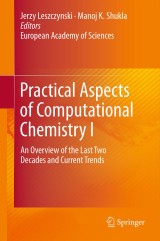Details

Practical Aspects of Computational Chemistry I
An Overview of the Last Two Decades and Current Trends|
CHF 236.00 |
|
| Verlag: | Springer |
| Format: | |
| Veröffentl.: | 02.01.2012 |
| ISBN/EAN: | 9789400709195 |
| Sprache: | englisch |
| Anzahl Seiten: | 680 |
Dieses eBook enthält ein Wasserzeichen.
Beschreibungen
<p><i>Practical Aspects of Computational Chemistry I: An Overview of the Last Two Decades and Current Trends</i> gathers the advances made within the last 20 years by well-known experts in the area of theoretical and computational chemistry and physics. The title itself reflects the celebration of the twentieth anniversary of the “Conference on Current Trends in Computational Chemistry (CCTCC)” to which all authors have participated and contributed to its success. </p><p>This volume poses (and answers) important questions of interest to the computational chemistry community and beyond. What is the historical background of the “Structural Chemistry”? Is there any way to avoid the problem of intruder state in the multi-reference formulation? What is the recent progress on multi-reference coupled cluster theory? Starting with a historical account of structural chemistry, the book focuses on the recent advances made in promising theories such as many body Brillouin-Wigner theory, multireference state-specific coupled cluster theory, relativistic effect in chemistry, linear and nonlinear optical properties of molecules, solution to Kohn-Sham problem, electronic structure of solid state materials, development of model core potential, quantum Monte Carlo method, nano and molecular electronics, dynamics of photodimerization and excited states, intermolecular interactions, hydrogen bonding and non-hydrogen bonding interactions, conformational flexibility, metal cations in zeolite catalyst and interaction of nucleic acid bases with minerals. </p><p><i>Practical Aspects of Computational Chemistry I: An Overview of the Last Two Decades and Current Trends</i> is aimed at theoretical and computational chemists, physical chemists, materials scientists, and particularly those who are eager to apply computational chemistry methods to problem of chemical and physical importance. This book will provide valuable information to undergraduate, graduate, and PhD students aswell as to established researchers.</p>
Models—experiment—computation: a history of ideas in structural chemistry.- Many-Body Brillouin-Wigner Theories: Development and Prospects.- Multireference state-specific coupled cluster theory with a complete active space reference.- Relativistic effects in chemistry and a two-Component theory.- On the electronic, vibrational and relativistic contributions to the linear and nonlinear optical properties of molecules.- Using Chebyshev-Filtered Subspace Iteration and Windowing Methods to Solve the Kohn-Sham Problem.- Electronic structure of solids and surfaces with WIEN2k.- Model core potential method in the first decade of the XXI century.- Practical Aspects of Quantum Monte Carlo for the Electronic Structure of Molecules.- Relativistic Quantum Monte Carlo Method.- Computer Aided Nanomaterials Design – Selfassembly, Nanooptics, Molecular electronics/spintronics, and Fast DNA sequencing.- Computational Molecular Engineering for Nanodevices and Nanosystems.- Theoretical Studies of Thymine-Thymine Photodimerization: Using Ground State Dynamics to Model Photoreaction.
Practical Aspects of Computational Chemistry I: An Overview of the Last Two Decades and Current Trends gathers the advances made within the last 20 years by well-known experts in the area of theoretical and computational chemistry and physics. The title itself reflects the celebration of the twentieth anniversary of the “Conference on Current Trends in Computational Chemistry (CCTCC)” to which all authors have participated and contributed to its success.
This volume poses (and answered) important questions of interest to the computational chemistry community and beyond. What is the historical background of the “Structural Chemistry”? Is there any way to avoid the problem of intruder state in the multi-reference formulation? What is the recent progress on multi-reference coupled cluster theory?
Starting with a historical account of structural chemistry, the book focuses on the recent advances made in promising theories such as many body Brillouin-Wigner theory, multireference state-specific coupled cluster theory, relativistic effect in chemistry, linear and nonlinear optical properties of molecules, solution to Kohn-Sham problem, electronic structure of solid state materials, development of model core potential, quantum Monte Carlo method, nano and molecular electronics, dynamics of photodimerization and excited states, intermolecular interactions, hydrogen bonding and non-hydrogen bonding interactions, conformational flexibility, metal cations in zeolite catalyst and interaction of nucleic acid bases with minerals.
This volume is aimed at theoretical and computational chemists, physical chemists, materials scientists, and particularly those who are eager to apply computational chemistry methods to problem of chemical and physical importance. This book will provide valuable information to undergraduate, graduate, and PhD students as well as to established researchers.
This volume poses (and answered) important questions of interest to the computational chemistry community and beyond. What is the historical background of the “Structural Chemistry”? Is there any way to avoid the problem of intruder state in the multi-reference formulation? What is the recent progress on multi-reference coupled cluster theory?
Starting with a historical account of structural chemistry, the book focuses on the recent advances made in promising theories such as many body Brillouin-Wigner theory, multireference state-specific coupled cluster theory, relativistic effect in chemistry, linear and nonlinear optical properties of molecules, solution to Kohn-Sham problem, electronic structure of solid state materials, development of model core potential, quantum Monte Carlo method, nano and molecular electronics, dynamics of photodimerization and excited states, intermolecular interactions, hydrogen bonding and non-hydrogen bonding interactions, conformational flexibility, metal cations in zeolite catalyst and interaction of nucleic acid bases with minerals.
This volume is aimed at theoretical and computational chemists, physical chemists, materials scientists, and particularly those who are eager to apply computational chemistry methods to problem of chemical and physical importance. This book will provide valuable information to undergraduate, graduate, and PhD students as well as to established researchers.
Written to attract newcomers to the field of computational chemistry Free from complicated theoretical chemistry jargon Provides rudimentary concepts required to grasp the basics Aimed at professionals in the physical sciences, biological sciences, and materials science

















